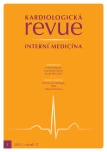TDM of digoxin in clinical practice
Authors:
M. Grundmann 1; I. Kacířová 1,2
Authors‘ workplace:
Ústav klinické farmakologie, LF OU, Ostrava
1; Oddělení klinické farmakologie, Ústav laboratorní dia gnostiky, FN Ostrava
2
Published in:
Kardiol Rev Int Med 2015, 17(1): 65-69
Category:
Internal Medicine
Overview
Introduction:
Digoxin is a positive inotropic drug frequently prescribed in the treatment of chronic congestive cardiac failure. Recent evidence suggests that a lower therapeutic range of 0.5 – 0.9 ng/ mL is associated with reduced mortality. With complex pharmacokinetic profile and narrow therapeutic index, its use in managing patients with heart failure can present a challenge to clinicians.
Aim:
To show the advantages of therapeutic drug monitoring for dosing of digoxin.
Method:
Bayesian analysis was used to predict the long‑term serum concentration – time profiles of digoxin, using the MW ‑ Pharm 3.30 software. The serum levels of digoxin were determined by MEIA.
Results:
Three case reports are presented showing a prediction of steady ‑ state digoxin level three days after the start of administration, drug‑drug interaction between digoxin and spironolactone/ carvedilol and an example of long‑term patient non‑compliance.
Conclusion:
Therapeutic drug monitoring is very useful for prediction of serum levels of digoxin alone and in combination with different interacting drugs. It helps to understand compliance ‑ influencing factors and to improve interventional strategies to increase digoxin compliance.
Keywords:
chronic heart failure – digoxin – therapeutic drug monitoring – compliance – drug‑drug interactions
Sources
1. McMurray JJ, Adamopoulos S, Anker SD et al. ESC Committee for Practice Guidelines. ESC guidelines for the diagnosis and treatment of acute and chronic heart failure 2012: The Task Force for the Diagnosis and Treatment of Acute and Chronic Heart Failure 2012 of the European Society of Cardiology. Developed in collaboration with the Heart Failure Association (HFA) of the ESC. Eur J Heart Fail 2012; 14 : 803 – 869. doi: 10.1093/ eurjhf/ hfs105.
2. Špinar J, Vítovec J, Hradec J et al. Doporučený postup České kardiologické společnosti pro diagnostiku a léčbu chronického srdečního selhání 2011. Cor Vasa 2012; 54 : 113 – 134.
3. Hood WB Jr, Dans AL, Guyatt GH et al. Digitalis for treatment of heart failure in patients in sinus rhythm. Cochrane Database Syst Rev 2014; 4: CD002901. doi: 10.1002/ 14651858.CD002901.pub3.
4. The Digitalis Investigation Group. The effect of digoxin on mortality and morbidity in patients with heart failure. N Engl J Med 1997; 336 : 525 – 533.
5. Rathore SS, Curtis JP, Wang Y et al. Association of serum digoxin concentration and outcomes in patients with heart failure. JAMA 2003; 289 : 871 – 878.
6. Ahmed A, Waagstein F, Pitt B et al. Effectiveness of digoxin in reducing one‑year mortality in chronic heart failure in the Digitalis Investigation Group trial. Am J Cardiol 2009; 103 : 82 – 87. doi: 10.1016/ j.amjcard.2008.06.068.
7. Gheorghiade M, van Veldhuisen DJ, Colucci WS. Contemporary use of digoxin in the management of cardiovascular disorders. Circulation 2006; 113 : 2556 – 2564.
8. Gheorghiade M, Ferguson D. Digoxin. A neurohormonal modulator in heart failure? Circulation 1991; 84 : 2181 – 2186.
9. Grundmann M, Kacířová I. Význam TDM, fenotypizace a genotypizace pro správné dávkování léčiv. Čas Lék čes 2010; 149 : 482 – 487.
10. Grundmann M. 30 let klinické farmakologie ve zdravotnických zařízeních České republiky. Klin Farmakol Farm 2008; 22 : 127 – 129.
11. Kakumoto M, Takara K, Sakaeda T et al. MDR1 – mediated interaction of digoxin with antiarrhythmic or antianginal drugs. Biol Pharm Bull 2002; 25 : 1604 – 1607.
12. Ehle M, Patel C, Giugliano RP. Digoxin: clinical highlights: a review of digoxin and its use in contemporary medicine. Crit Pathw Cardiol 2011; 10 : 93 – 98. doi: 10.1097/ HPC.0b013e318221e7dd.
13. Alušík Š, Paluch Z, Lejsková M et al. Neuropsychiatrické projevy u intoxikace digoxinem. Klin Farmakol Farm 2009; 23 : 162 – 165.
14. Kacířova I, Grundmann M, Halvová P. TDM of digoxin and theophylline as an indicator of the quality of medical care in University Hospital Ostrava – results of the 5‑years monitoring. Abstract of IATDMCT European Therapeutic Drug Monitoring ‑ Personalised Pharmacotherapy Conference 2014; S101.
15. Cline CM, Bjorck ‑ Linne AK, Israelsson BY et al. Non ‑ compliance and knowledge of prescribed medication in elderly patients with heart failure. Eur J Heart Fail 1999; 1 : 145 – 149.
16. Goodyer LI, Miskelly F, Milligan P. Does encouraging good compliance improve patients’ clinical condition in heart failure? Br J Clin Pract 1995; 49 : 173 – 176.
17. van der Wal MH, Jaarsma T, van Veldhuisen DJ. Non ‑ compliance in patients with heart failure; how can we manage it? Eur J Heart Fail 2005; 7 : 5 – 17.
18. Kongkaew C, Sakunrag I, Jianmongkol P. Non ‑ compliance with digoxin in patients with heart failure and/ or atrial fibrillation: a systematic review and meta‑analysis of observational studies. Arch Cardiovasc Dis 2012; 105 : 507 – 516. doi: 10.1016/ j.acvd.2012.06.004.
Labels
Paediatric cardiology Internal medicine Cardiac surgery CardiologyArticle was published in
Cardiology Review

2015 Issue 1
Most read in this issue
- TDM of digoxin in clinical practice
- Drug interaction and current clinical practice
- Cardiac resynchronization therapy – when should it be indicated and for whom?
- TDM of antibiotics in clinical practice
